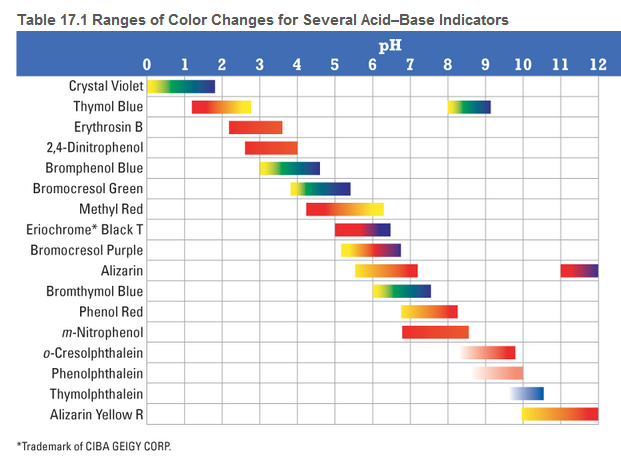
Concept explainers
Sketch the titration curve from Problem 121 by calculating the pH at the beginning of the titration, at one-half of the equivalence point, at the equivalence point, and at 5.0 mL beyond the equivalence point. Pick a suitable indicator for this titration from Table 17.1
by calculating the pH at the beginning of the titration, at one-half of the equivalence point, at the equivalence point, and at 5.0 mL beyond the equivalence point. Pick a suitable indicator for this titration from Table 17.1 
121. A 0.552-g sample of ascorbic acid (vitamin C) is dissolved in water to a total volume of 20.0 mL and titrated with 0.1103 M KOH. The equivalence point occurs at 28.42 mL. The pH of the solution at 10.0 mL of added base was 3.72. From this data, determine the molar mass and Kafor vitamin C.

Want to see the full answer?
Check out a sample textbook solution
Chapter 18 Solutions
Chemistry: Structures and Properties, Books a la Carte Plus MasteringChemistry with eText -- Access Card Package
Additional Science Textbook Solutions
Concepts of Genetics (12th Edition)
Organic Chemistry
MARINE BIOLOGY
Fundamentals of Anatomy & Physiology (11th Edition)
- 3.2 32 Consider calibrating a calorimeter and measuring heat transferred. A sample of compound was burned in a calorimeter and a temperature change of 3.33°C recorded. When a 1.23 A current from a 12.0 V source was passed through a heater in the same calorimeter for 156 s, the temperature changed of 4.47°C was recorded. 3.2.1 Calculate the heat supplied by the heater. 3.2.2 Calculate the calorimeter constant. 3.2.3 Calculate the heat released by the combustion reaction.arrow_forward-.1 Consider the standard enthalpy of formation of gaseous water at 25°C as -241.82 kJ/mol and calculate the standard enthalpy of formation of gaseous water at 100°C.arrow_forward3.5 Complete the following sentences to make correct scientific meaning. 3.5.1 The entropy of a perfect gas. 3.5.2 when it expands isothermally. The change in entropy of a substance accompanying a change of state at its transition 3.5.3 temperature is calculated from its of transition. The increase in entropy when a substance is heated is calculated from itsarrow_forward
- 3.4 Consider the internal energy of a substance 3.4.1 Draw a graph showing the variation of internal energy with temperature at constant volume 3.4.2 Write the mathematical expression for the slope in your graph in 3.4.1arrow_forwardFor a system, the excited state decays to the ground state with a half-life of 15 ns, emitting radiation of 6000 Å. Determine the Einstein coefficients for stimulated absorption and spontaneous emission and the dipole moment of the transition. Data: epsilon 0 = 8.85419x10-12 C2m-1J-1arrow_forwardProblem a. The following compounds have the same molecular formula as benzene. How many monobrominated products could each form? 1. HC =CC=CCH2CH3 2. CH2=CHC = CCH=CH₂ b. How many dibrominated products could each of the preceding compounds form? (Do not include stereoisomers.)arrow_forward
- Don't used Ai solutionarrow_forward4.3 Explain the following terms: 4.3.1 Normal boiling point. 4.3.2 Cooling curve. 4.3.3 Congruent melting. 4.3.4 Ideal solution. 4.3.5 Phase diagram of a pure substance.arrow_forwardFor CO, an electronic transition occurs at 2x1015 Hz. If the dipole moment of the transition is of the order of 1 Debye, calculate:a) The Einstein coefficient of stimulated emissionb) The lifetime of the excited statec) The natural width (in Hz)Data: epsilon 0 = 8.85419x10-12 C2m-1J-1; 1 D = 3.33564x10-30 C m;arrow_forward
- A radiation of intensity l0 = 2.5x1010 photos s-1 cm2 affects a dispersion and produces a transmittance of 0.1122. How much incident radiation is absorbed by the music screen?arrow_forwardIf a radiation intensity l0 = 2.5x1010 fotones s-1 cm2 causes a dissolución and an absorbance of 0.95 will be recorded. How much incident radiation is absorbed by the music screen?arrow_forwardFrom the causes of the detection of a spectral band of a spectrum obtained by a signal in the gaseous phase that is indicated, you can avoid or minimize those that have their origin in:a) the Doppler effectb) collisionsc) the life time of the excited statearrow_forward
 General Chemistry - Standalone book (MindTap Cour...ChemistryISBN:9781305580343Author:Steven D. Gammon, Ebbing, Darrell Ebbing, Steven D., Darrell; Gammon, Darrell Ebbing; Steven D. Gammon, Darrell D.; Gammon, Ebbing; Steven D. Gammon; DarrellPublisher:Cengage Learning
General Chemistry - Standalone book (MindTap Cour...ChemistryISBN:9781305580343Author:Steven D. Gammon, Ebbing, Darrell Ebbing, Steven D., Darrell; Gammon, Darrell Ebbing; Steven D. Gammon, Darrell D.; Gammon, Ebbing; Steven D. Gammon; DarrellPublisher:Cengage Learning ChemistryChemistryISBN:9781305957404Author:Steven S. Zumdahl, Susan A. Zumdahl, Donald J. DeCostePublisher:Cengage Learning
ChemistryChemistryISBN:9781305957404Author:Steven S. Zumdahl, Susan A. Zumdahl, Donald J. DeCostePublisher:Cengage Learning Chemistry: An Atoms First ApproachChemistryISBN:9781305079243Author:Steven S. Zumdahl, Susan A. ZumdahlPublisher:Cengage Learning
Chemistry: An Atoms First ApproachChemistryISBN:9781305079243Author:Steven S. Zumdahl, Susan A. ZumdahlPublisher:Cengage Learning
 Chemistry: Principles and ReactionsChemistryISBN:9781305079373Author:William L. Masterton, Cecile N. HurleyPublisher:Cengage Learning
Chemistry: Principles and ReactionsChemistryISBN:9781305079373Author:William L. Masterton, Cecile N. HurleyPublisher:Cengage Learning Chemistry: Principles and PracticeChemistryISBN:9780534420123Author:Daniel L. Reger, Scott R. Goode, David W. Ball, Edward MercerPublisher:Cengage Learning
Chemistry: Principles and PracticeChemistryISBN:9780534420123Author:Daniel L. Reger, Scott R. Goode, David W. Ball, Edward MercerPublisher:Cengage Learning





